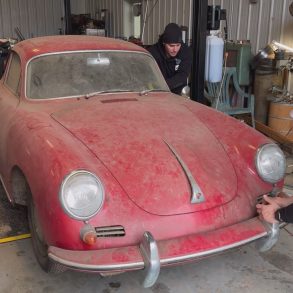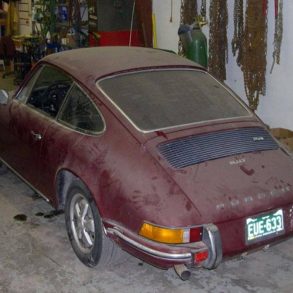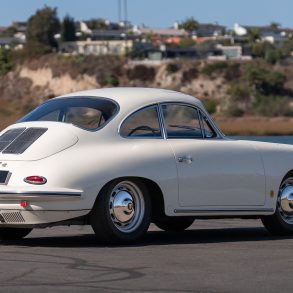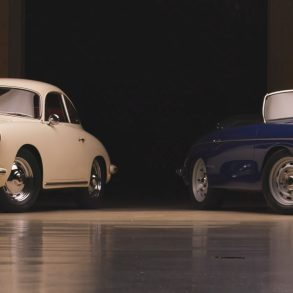The Audiobahn E5: The Porsche 911 G Series (& the Turbo)
Welcome to The Audiobahn, the Stuttcars.com podcast focused on all things Porsche. In our first series, we’re exploring the history of venerable 911: its history, origins, achievements, and future.
Audiobahn Episode Four is all about the Porsche 911G and 911 Turbo.
Read the Podcast Transcript
B: Hey everyone and welcome to the Audiobahn. I’m Brayden Clark and this is Chris Carnduff. This is your Porsche podcast where we dive into the really well-written articles on stuttcars.com and bring you really fun, informative video segments on those articles. Over this past series we’ve been going into the history of the 911, all the way from the 356, and all the way up until modern day. Last week we talked about, among other things, the 911 R, and this week we’re getting into the Turbo.
C: Yep. And the G Series.
B: The G Series. Chris, are you ready?
C: I’m ready, are you ready?
B: I’m absolutely ready, let’s go.
Okay what are we talking about this week?
C: We’re talking about the G Series.
B: Okay.
C: So the first kind of sub generation or series of 911’s happened until about 1972-1973 therein. There was a half year model there in 1973 that was still a part of the first series, but the G Series came hot on the heels of the first series and this came with a few different changes. Came with a few body changes and it also came with an engine change. As far as the looks and the body go, well we’ll talk more about that a little bit later. But as far as the looks go, this was mostly influenced by American safety standards.
In the 70s, if you wanted to sell your car in the United States, you had to capitulate with their new safety standards and this is where we get the bench seat bumper.
B: The big disgusting things, I hate them.
C: The lovely Chrome bits that you see all over cars in the 70s that are way too big. Hey mind you, Porsche integrated them to the body way better than a lot of Manufacturers did, better than American manufacturers did as well, which I think is kind of hilarious because the Americans, you know, kind of knew what was coming in the United States. But with that safety equipment the car also got heavier, because more equipment equals more weight. But with that more weight, Porsche also gave you 35% more displacement on your engine.
So instead of selling their 911s with just a 2-litre engine, now they were selling them with a 2.7 litre engine, so they put out, what do you know, more power. Now Porsche did have a weird kind of thing. So we have the 2.7 litre engine that comes in the G Series, but there is that weird half year.
B: Okay.
C: So in that weird half year they had a 911 S that was a 2.4 litre engine, and it wasn’t just because they wanted a new engine in it.
B: Right.
C: So the G Series has the 2.7, and this 2.4 that’s in the 911 S during the 72-73 kind of model year is different, not because of the engine, but because of some debugging. Interesting, okay. So let’s talk weight distribution.
911s, no matter how powerful or un-powerful they are, even 912s, demand that you are not just a mediocre driver, and demand not that you’re an average driver, they demand you to be a good driver. And the reason for that is because all the weight is in the back and not just in the back, in the back, right. So this isn’t just like.
B: It’s far in the back.
C: It is behind the rear axle in the back. It is so far back there. Now this is great if you want to take off the line, right. You put your foot down and all that weight is forcing that rear axle onto the surface of the planet Earth.
B: Yep.
C: And it means that you can take off with a lot of grip and a lot of traction. The problem comes whenever you decide to turn the corner, right. Front of the car moves out of the way. And the back just keeps on going. Inertia is a Fickle mistress and pushes it along and if you don’t know what you’re doing, you don’t know how to handle it, then lo and behold, you become a victim of physics. And you’re off the road and who knows what happens. So these are cars that demand you to be a good driver.
There are a few ways you can make that more manageable, and Porsche in that 72-73 year, with the 911s with the 2.4 litre engine, they, to try to make it more manageable, they extended the wheelbase by a few inches, so now it had an 89.4 inch wheelbase, just a little bit longer. They also added some weight on the front bumper, which was certainly helped by the bench seat bumpers, which counteracted that balance a little bit. It made your weight distribution a bit better, but it’s still not perfect. It still demands you to be a great driver.
B: Yeah.
C: So Brayden.
B: Christopher?
C: If you were an automotive manufacturer who had a car that was really hard to control and you didn’t really have a good way to make it better, what would you do?
B: I have, uh hold on, let me think of this, A, Probably not give it more power, which is what I think you’re leading towards them doing. Probably rework the suspension.
C: Yeah or like change the geometry or something, right.
B: Yeah.
C: So that’s not what they did. Yeah, Porsche does something way cooler. They do the better thing, right. Yeah they look at it and they go, oh you’re a bad driver. Well you know they kind of have the Dark Souls answer to it, it’s just, get good, you know. So instead of… In 1974 they do the thing.
So if you go to your local car swap meet, you’re going to find two kinds of 20 year olds. The first kind of 20 year old is going to, you know, their answer to every single question will be, well, there’s no replacement for displacement, right. And God bless them. But the other kind of 20 year old you’re gonna find; the first question about a car will always be, how much boost is that running bro? And those are kind of the two people you get, and I know because I was one. I was, I was both of those things at different times in my 20s. But in 1974 Porsche kind of went, oh yeah those, are both good ideas.
B: More power.
C: You got it. So they decided that Turbos were the way of the future and that in order to have a turbocharged engine they were also going to have to make it a little bit bigger. So in 1974 saw, with the G Series, the introduction of the G Series, saw the first iteration of maybe the coolest car ever made. And also maybe the most dangerous car ever made, the 930 911 Turbo. And it had a three litre engine with a Turbocharger and it put out 260 horsepower. Do you want to read out the quick specs on that car?
B: Absolutely. Okay so that three litre engine was obviously putting out 260 brake horsepower, which gave it a 0-60 of 6.1 seconds, a top speed of 153 miles per hour, generating 254 pound-feet of torque at 4000 RPM, all in a vehicle weighing 2,635 pounds. So definitely heavier than previous Porsches, but still pretty light.
C: Certainly yeah, light by today’s standards for sure. Heavier for those Porsches. I think this might be the most dangerous car ever made and it’s because they sold it to Americans. And this isn’t a slight at Americans. This is a slight at, I don’t even think it’s a slight at anybody, it’s just kind of what was the case, right.
So in 1974 or 1973 they were selling these to Americans, but Americans were used to buying, you know, Mustangs, and Chevelles, and Camaros, and Chargers ,and Challengers So I’ll let power right at the front. All at power right at the front. But also, all of them were advertised as having like 400 horsepower. Oh yeah. So 300 horsepower is the smallest you could get, you know, so they were measuring horsepower differently back then. And Americans would look at that and they go “oh it’s only got 260 horsepower, I can handle that, that’s not a problem”, and it created many victims of physics. So it’s a part of the legend of this car, right. TV episodes have been made about the turbo 911 that killed, you know, X person, and you know, went down the line. There’s an episode of Supernatural all about that.
B: Interesting.
C: Yeah.
B: For all of our Supernatural fans, that’s in there just for you.
C: It’s like the car was cursed. Well actually, it wasn’t cursed.
B: It was just a 911.
C: So that model, that wasn’t just called the 911, it was the 930 911, and it’s an important, I mean a wildly important part of 911 history. And you can tune in next week when we go into far more about the engine, what it was doing and its development throughout the 70s.
B: Okay so to recap, this was an initial dive into the 930 911, as well as a look at the 911 G Series, starting in, well starting around 1974, but with a weird half year before that. Next week we’re going to do an even deeper dive into the 930 911 and why it’s so important to the history of this fantastic car.
Chris, this was fun.
C: This is a fun episode.
B: It’s a fun episode. I want to go drive one now.
Thank you guys so much for tuning in. If you want to read more about the awesome cars that we look into, go to stuttcars.com. They’ve got so many articles about the 911 and about different Porsches, as well as the history of Porsche in general.
We’ll see you next week. Thanks for joining us.
C: Yeah, thanks very much. Yeah you should drive one, you know it’s only 260 horsepower, I’m sure you can handle it.
B: I can handle that, I can handle that.










